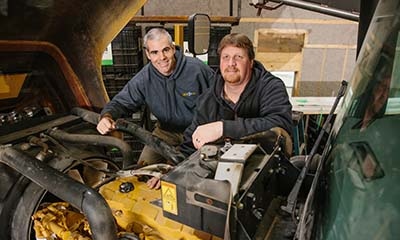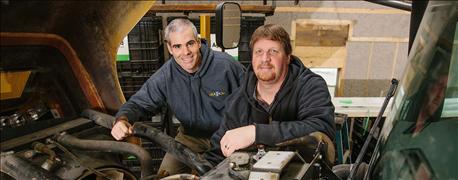
Kyle Stackhouse doesn’t love doing machinery maintenance. But that hasn’t stopped him and his dad, Brad, from doing most of their own repairs to keep a lid on costs for their family’s 3,500-acre corn and soybean operation in northwest Indiana.
With dealerships charging $60 an hour or more for machinery repairs, and with hiring a full- or part-time mechanic being too expensive, the Stackhouses keep farm costs down by doing as much maintenance themselves on things like changing bearings or cultivator blades.

Indiana farmer Kyle Stackhouse (left) relies on self-employed mechanic Stan Murphy to fix some of the farm’s equipment. Photo by Grant Thompson
“Is it something I want to do myself? No. But is it something we do ourselves a lot of times? Yes,” he says. “Obviously, some of that work has to go to a dealer. The more technologically advanced things get, the more you have to go to the dealer, and you’re pretty much left with no options.”
For bigger maintenance projects, they call on Stan Murphy, a self-employed local mechanic who runs his own shop, Classic Truck and Tractor. These days Murphy keeps a busy schedule.
Murphy not only comes with the right resume and experience of having worked at a local dealership, but also does maintenance at a fraction of the cost compared to most dealerships, Stackhouse says.
“He’s half to two-thirds the dealer rate,” he says. “We’ll use him for anything more in-depth than we want to tackle, or just when we don’t have time to do it. That’s worked out pretty well.”
High-Priced Dealers
When it comes to technologically advanced maintenance on today’s self-propelled sprayers, tractors and combines, even Murphy admits some machinery problems require dealers to diagnose.
“General repairs I can take care of, but the newer equipment is more and more computerized,” Murphy says. “To my knowledge, the computer systems and the software to diagnose the electronic problems aren’t available aftermarket, and the corporations aren’t allowing that software to be distributed outside of the company. The dealers kind of have a corner on that.”
With today’s highly advanced machinery, turning to dealers for maintenance regardless of the cost is the price of doing business in farming, says Kelvin Leibold, Extension farm management specialist at Iowa State University.
While farmers can still do lots of routine maintenance in the farm shop, more machinery problems these days require a dealer for diagnosing the issue, Leibold explains.
“These dealerships are challenged with generating some revenue and trying to maintain profitability, so the days of walking into the back of the shop and talking to the shop manager about how to diagnose what’s wrong with my transmission may be over,” Leibold says. “Today he might say, ‘Well, let me just get online and I’ll talk to your tractor. And oh, by the way, what’s your account number?’ That service may run at a $100-per-hour rate.”
With newer equipment, warranties will cover the cost of maintenance, Leibold says. But if the machinery no longer is covered by warranty, the farmer will have to make a decision for each piece of equipment and diagnostic issue.
If farmers are intent on doing more work themselves, Leibold says they will have to do a self-assessment of their skills, tools and their shop’s capacity.
Ability to diagnose the problem is also crucial.
“A worn-out cultivator sweep? That’s pretty easy to diagnose,” he says. “The fact that your tractor does funny things between 12th gear and 13th gear when it shifts? That’s a lot more complex.”
Online discussion forums with other farmers or mechanics, says Leibold, also offer opportunities for farmers to self-diagnose and repair machinery on-farm.
Last Option: Do Nothing
Putting off major overhauls might be the best option for reducing maintenance costs in the near term if the issues aren’t serious, adds William Edwards, retired ag economist at Iowa State University.
“Postponing expenses is one of the ways you can deal with a slump in farm profits,” notes Edwards. “You have to make a judgment call if you want to spend money now or if you can wait another year. Many farmers updated their machinery lines a few years ago when crop prices were high, so their repair costs should be on the low side for a few more years.”
Leibold agrees that spreading costs by delaying maintenance might be the best option for cash-strapped farmers, adding that doing nothing — or next to nothing — might become more popular as farmers feel the pressure of low commodity prices. The risk, though, is having costlier breakdowns in the future.
As for Stackhouse, it’s the do-it-yourself attitude that is essential to surviving this downturn in agriculture. “We’re pretty much self-sufficient, but if we had a choice, we’d find a retired guy who wants to work part time and keep him busy two or three days a week taking care of our all our shop stuff,” he says. “But we still haven’t found that guy yet.”
Ehmke writes from Englewood, Colo.
About the Author(s)
You May Also Like




